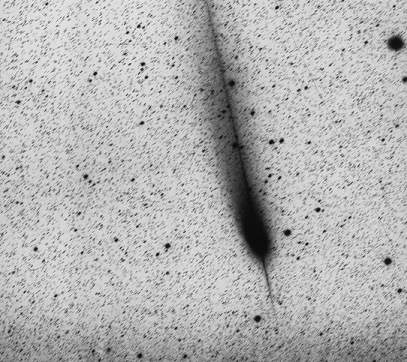
|
Credit: Guido Pizarro,
ESO
Explanation:
Where is Hale-Bopp now?
The Great Comet of 1997,
one of the largest and most active comets ever,
is outbound about 400 million miles from the sun.
Too faint for viewing without telescopes or binoculars, Hale-Bopp
is presently positioned
in the very southerly constellation of Pictor.
This "negative" image (black stars against white sky) of Hale-Bopp
is the result of a 1 hour time exposure using the 1-metre
European Southern Observatory Schmidt telescope on January 5.
Clearly the comet still has
a substantial tail, blown by
the solar wind,
that points generally away from the sunward direction.
But look closely.
A spiky "anti-tail" is also visible pointing toward the sun!
It is likely that this anti-tail is composed of dust grains released
from the comet nucleus
which are too large to be easily pushed by the solar wind.
As Hale-Bopp recedes
from the sun its activity will subside but astronomers
are still uncertain as to how long its tails will last.
After a swing through the outer solar system and
the Oort cloud,
Hale-Bopp will pass through the inner solar system again ...
around the year 5400.
|
January February March April May June July August September October November December |
| ||||||||||||||||||||||||||||||||||||||||||||||||
NASA Web Site Statements, Warnings, and Disclaimers
NASA Official: Jay Norris. Specific rights apply.
A service of: LHEA at NASA / GSFC
& Michigan Tech. U.
Based on Astronomy Picture
Of the Day
Publications with keywords: tail - Comet Hale-Bopp
Publications with words: tail - Comet Hale-Bopp
See also:
